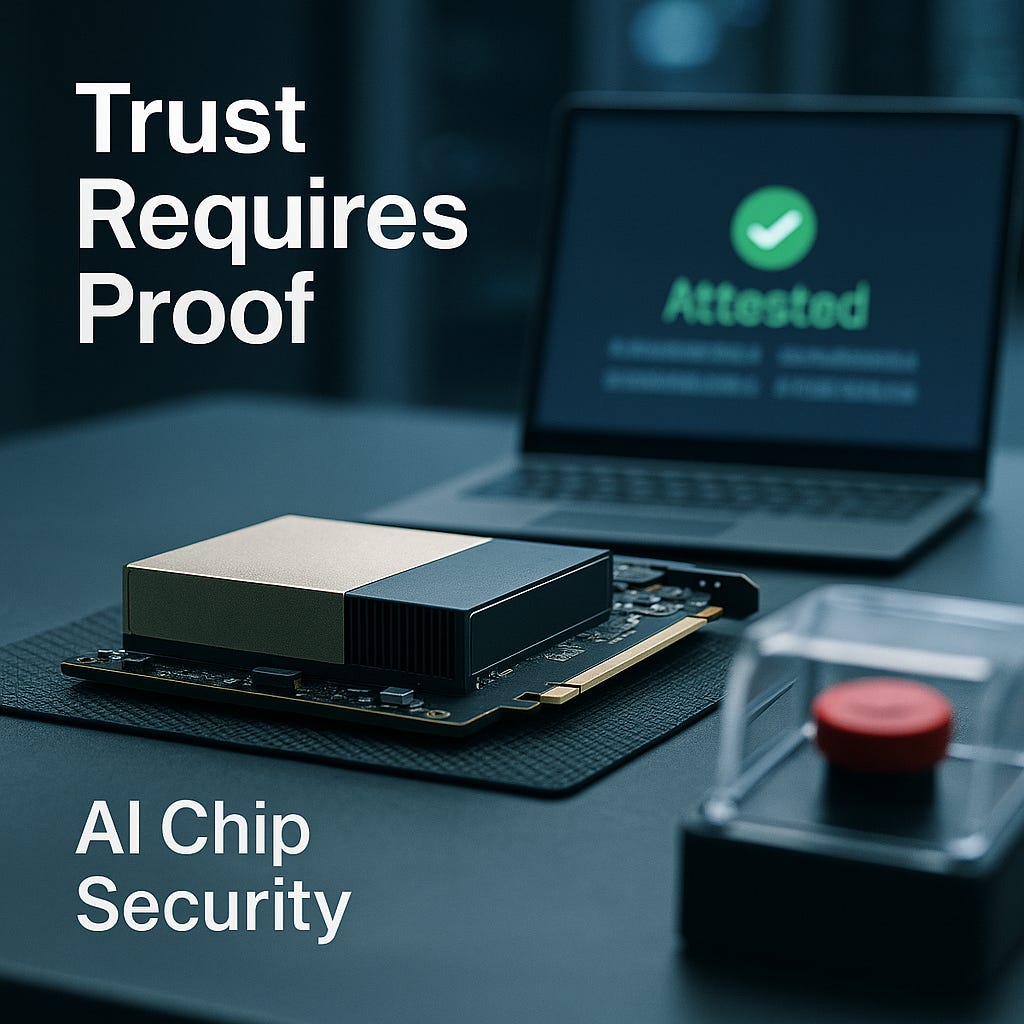AI Chip Security: Trust Without Kill Switches
Set a higher bar for AI chip security with proof, not posture. No kill switches, real attestation, clean SBOMs.
AI chip security is now a buying decision, not a belief. If you sell into critical workflows, you earn trust with proof, not by posturing. That starts with clarity on backdoors, kill switches, and the Washington push to make chips “location-verifiable.” The stakes are simple. Either the supply chain proves the absence of hidden control, or buyers price in the risk and move on.
The line on kill switches: table stakes, not a headline
NVIDIA came out swinging last week and put a line in the sand: no backdoors, no kill switches, no spyware. Good. That should be the baseline. I agree that hard-coded remote controls create single points of failure and hand adversaries a roadmap. The Clipper Chip era taught the same lesson. We don’t weaken infrastructure to chase a policy goal. We strengthen it with layered controls, third-party validation, and real incident response. (NVIDIA Blog)
We need to move forward with what matters for buyers: proof they can verify in their own environments. That means attestation that maps to what you deploy, contracts that give you audit rights, and a clean story for firmware, drivers, and revocation. No drama. Just discipline.
Location verification in Washington: what it is and why I oppose it
Congress is pushing the Chip Security Act. The current draft would require export-controlled AI chips to implement “location verification” within 180 days of enactment, plus mandatory diversion reporting, and a one-year study of “secondary mechanisms” that could modify functionality or hinder illicit use. Commerce could also maintain a registry with chip location and current end user. (Congress.gov)
Supporters frame this as an anti-smuggling control, not a backdoor. Some proposals describe a periodic challenge-response that estimates whether a chip sits in an approved region without continuous tracking. The idea targets gray-market routes and re-exports. On paper, it sounds good. In practice, it opens Pandora’s box. Once a control surface exists, incentives grow to expand it, wire it into policy swings, and stitch it across tools, drivers, and fabric all. That is how you turn a verification ping into a de facto remote control… one that our adversaries can exploit.
I oppose the mandate as written. It creates more risk than it removes and will age poorly. If governments are dumb enough to insist on this (and let’s face it… some if not most will), fence it to export-only SKUs, prove fail-safe design, and keep operational keys and logs out of vendor and agency hands. Even then, we should expect pressure to expand the scope, lengthen retention, and push continuous checks. Buyers need to plan for that risk.
China’s H20 scrutiny: use it to raise the bar for everyone
China’s regulator summoned NVIDIA to explain alleged “backdoor” risks in H20, and state media amplified the distrust. NVIDIA denied the claim and published a clear “no backdoors” rebuttal. Competing narratives will continue because the H20 is a political football. Rather than debate motives, use the moment to demand higher assurance, wherever you operate. Evidence wins.
My advice to vendors is to publish security whitepapers that match what you will actually run. Customers
My advice to organizations is to require attestable measurements of the GPU, driver, and firmware before workloads start, and require revocation that you can enforce. Treat claims the same way you treat SOC reports: useful, but not a substitute for validation.
AI chip security is earned in the stack you deploy
NVIDIA’s confidential computing architecture is real and evolving. Hopper introduced GPU confidential computing that binds workloads to a protected region and uses attestation with SPDM. Researchers also note current limits. Multi-GPU support has lagged in Hopper releases, NVLink traffic is unencrypted in current software, and Blackwell is expected to close some gaps, including link-level protections and trusted I/O.
Translation for non-hardware people: Today’s posture is strong for single-GPU confidential VMs, and tomorrow’s posture will be stronger across the fabric. Plan your controls around that roadmap.
Your policy should be business-driven and simple.
Shared cloud is fine for regulated data if you enforce strong controls and logs. In other words, do what you already should be doing. Look into “Gov Cloud” environments even if you are not required to run your workloads in them.
Verify attestation at job launch or at least per boot, and log those events.
Keep zeroization and firmware signing in scope for audits.
Drain jobs with alerts when trust checks fail, then block. No midnight surprises to the business.
If you do this well, you keep costs in check and avoid faux “private” builds that just move risk around.
Procurement that prices risk, not hope
Buyers need more than a promise. They need contract teeth.
Audit rights. Not a once-a-year beauty pageant. Real rights to test trust checks, inspect SBOMs for drivers, and validate revocation.
Attestation and measurement. Before workloads run, not after the fact.
Clear SLAs for key compromise and trust failures. Time to revoke. Time to patch. Time to notify.
Force vendors and cloud providers to state where location or control features do and do not exist. If any exist, lock down who holds keys, how long logs persist, and what triggers an enforcement action. If they will not commit, you price in the risk.
What I want from industry in 2025 and early 2026
I don’t need a government-run label this year, and frankly, that timeline is unrealistic. I want an industry-led bar that maps to what buyers can verify on day one. A coalition could publish a rubric that calls for:
Verifiable absence of vendor kill switches.
Documented attestation paths for GPU, driver, and firmware.
Memory scrubbing guarantees.
Evidence that link-level protections exist or a roadmap to Blackwell-era encryption where needed.
There is already enough momentum in confidential computing to get this done without waiting on statutes. Use the pressure from Washington and Beijing to move faster on proof, not policy.
Policy to policymakers: narrow the scope, or you will break trust
Call the problem what it is: diversion and smuggling. Tighten licensing, clean up due diligence, and resource enforcement. If you mandate location verification, limit it to export-only parts, define data minimization, cap retention, and bar continuous checks. Don’t ask private infrastructure to carry an open-ended control surface that will be attacked, abused, or extended in the next crisis. The Chip Security Act text already contemplates “secondary mechanisms” that may alter functionality. That’s a red flag for anyone who runs critical workloads.
CARE and RISE: where this fits
In CARE, this sits across Create and Run.
Create: write policy that bans embedded remote control, demands attestation, and defines zeroization. Bake it into design reviews for any new AI platform spend.
Run: enforce per-job or per-boot attestation, log to your SIEM, and test revocation paths during game days. Put GPU drivers and firmware in your patch calendar with business impact owners.
In RISE, this is Implement and Sustain, and Evaluate. Implement means you tie controls to contracts, budgets, and real deadlines, not wish lists. Sustain means you assume keys fail and plan the drain-then-block move.
Read more about the CARE and RISE approaches at RockCyber
.
The buyer’s reality in shared cloud
Most teams will not get dedicated hosts or private data centers for every regulated workload. That is fine. Make shared cloud safe with real controls:
Use confidential VMs and confidential GPUs when available.
Map your data-flow so secrets never leave confidential memory unprotected.
Treat multi-GPU training as a distinct risk class until your provider can prove link protections or trusted I/O on your target generation.
Put Multi-Instance GPU (MIG) in its place. It is a performance feature, not a security boundary. Pair it with confidential computing and strict monitoring if you must share.
When your provider’s story does not meet the bar, escalate to the business with dollar signs. “Prove it or get priced out.” That is how you move markets.
What I will not do
I will not put faith in a registry and a ping. I will not accept hidden enforcement surfaces in chips that run hospitals, planes, or the power grid. If a sovereign requires a remote disable for exports, fence it to export-only SKUs, prove fail-safe design, and keep control at the customer, not the vendor or a political office.
Where this goes next
Washington will keep pushing for technical controls. Beijing will keep probing for leverage. Vendors will keep publishing security blogs. The winners will prove their story with attestation, clean SBOMs, zeroization, and revocation that works under stress. That is where trust lives.
Key Takeaway: AI chip security is a trust problem. Prove it in my environment, or I price the risk and move on.
Call to Action
👉 Book a Complimentary AI Risk Review HERE
👉 Subscribe for more AI security and governance insights with the occasional rant.




